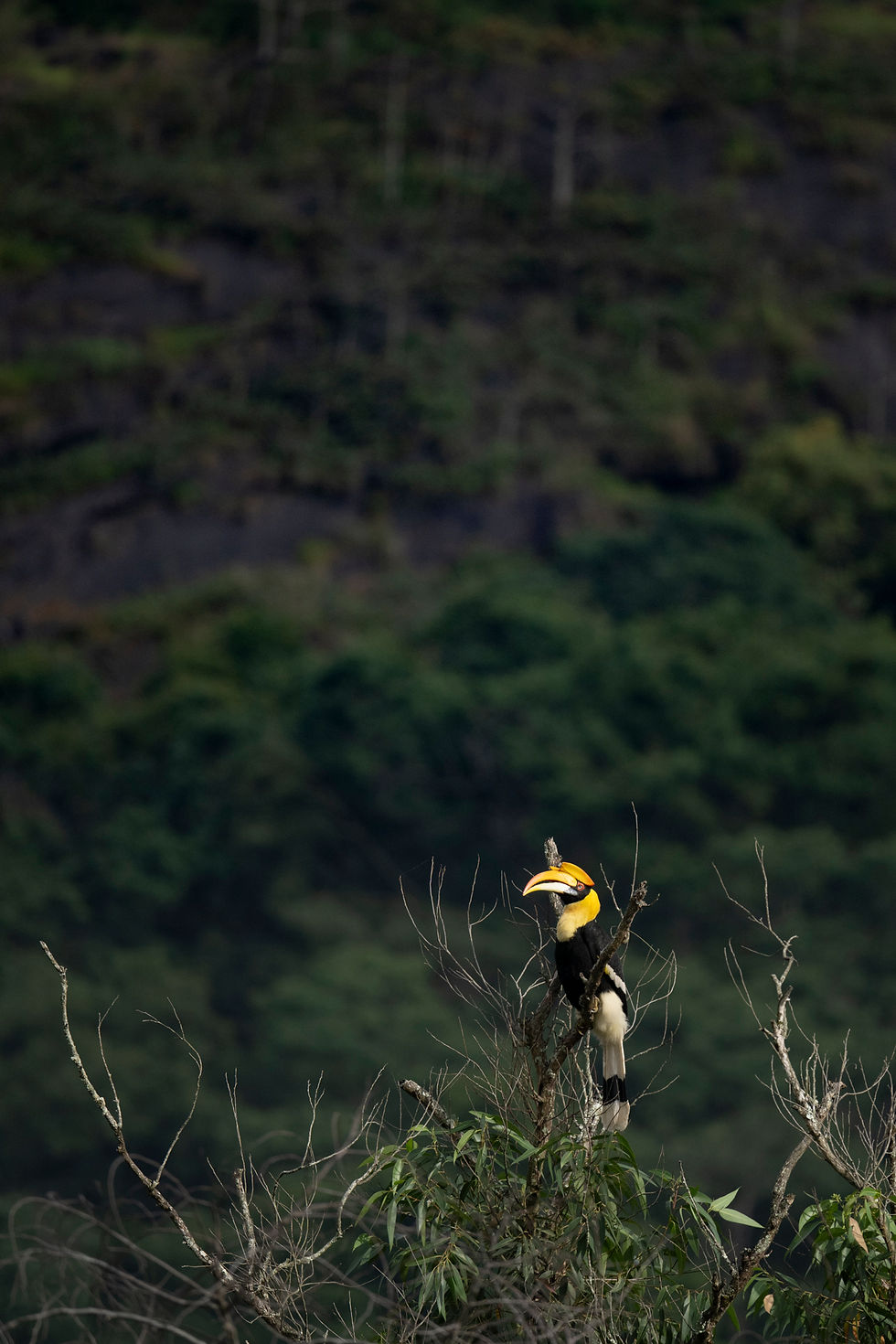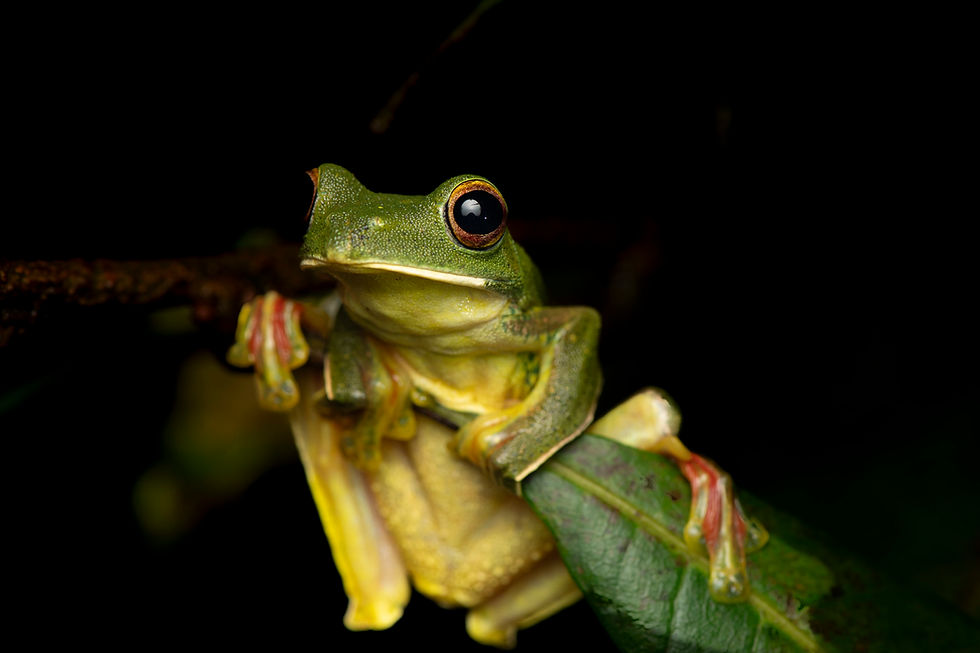The Elusive Hornbills
- Ashok Nair
- 23 hours ago
- 7 min read
The refreshing coolness of the air was what I first registered as I opened the door and stepped out onto the verandah. The joyous awareness of the musical symphony the birds were creating followed a second later.
That insouciant lad whistling gaily in the happy knowledge of the fact that he is going to be skipping school today ? That was the Malabar whistling thrush.
That pedantic knocking of a labourer going about his daily dreary tasks ? That was the barbet.
Then there was that irritated mother chiding her uncooperative child. And there, the clucking of an anxious grandparent fussing about the state of things in the world.
And a million other magical sounds.
“Lot of hornbill calls, sir,” Karupaswamy, the caretaker, happily commented as he walked past.
I put down my cup of tea to listen a little more carefully.
Sure enough...in the middle of all the sweet sounds of the various hill birds, I could hear the rasping cough that the hornbills’ calls sound like.
As a young school boy I had a book called the Birds of India or something similar. I must have pored over that book a million times, not as much from any love or fascination for birds as due to the simple fact that I was a voracious reader and just had to have a book in my hands. I don’t remember anything about the book other than two birds.
The first one was the hoopoe. As a young boy, I found their crown fascinating.
And the other was the bird that adorned the book’s cover. A pair of Great Indian Hornbills.
After a couple of failed plans over the last few years, I was here in the Anamalais on a solo trip, looking for the hornbills.
*****
The Great Indian Hornbill looks rather special.
Its most distinctive feature is obviously its bright orange, massive beak along with the casque, which is that hardened portion that rises to cover part of its head. Scientists have been unable to figure out the exact use of the casque, but some believe it might be for amplification of its calls.

The other fascinating part of the hornbill is its behavior after mating. To keep the eggs protected, the female will get into a hollow of a tree, cover the opening tight with a combination of mud and its own feces and stay put inside till the eggs are laid and hatched. Only its beak peeps out and the male dons the mantle of a dutiful mate and keeps coming over with food for the female.
The female stays cooped inside for almost 100 days. That's some dedication from the parents.
*****
‘Sir, hornbill !”, whispered, Chandru, my driver cum guide urgently.
We had been driving up and down the hills, visiting what my guide said were the usual spots the hornbills frequent for fruit. The jeep groaned over steep inclines, grumbled through muddy tracks. Around us, the tea estate spread out in all its pristine beauty, clad in a light shade of green, delicately manicured into neat, wavy boxes. A little further away behind them, where the hills rose, the trees stood, tall and foreboding, custodians of a thousand stories of the world around them.
We had not heard even a single call of the hornbill. Chandru had never been to a tiger reserve but in the true tradition of the typical guide in an Indian forest, he told me, “ Sir…just day before yesterday, I saw eight hornbills sitting on that tree.”
And a little later he sullenly reproached me for picking up the wrong time of the year to come. “ Sir, you have come late…in the season, the hornbills come so close sir….they sit on that tree and don’t get worried about us.”
But, yes, right now, he had spotted a pair.
The only problem was that they were hardly visible. Only their beaks could be occastionally seen. On top of that, the light was terrible. The sun was just about to disappear behind the hills and, right then, was outrageously flirting with some dark clouds.
My only hope was if the dying light could fall on that massive brilliant orange beak as it searched around for food.

Yeah...was hoping to get the light hit the hornbill's beak

Maybe the one with its mate is even better...what do you think ?
*****
“ Sir, don’t you want to see any other birds? Only hornbills ? “
Chandru was clearly not happy.
We were spying hornbills on almost every drive, but they were either too far or when they were a little closer, the setting was not great…actually, they were rather terrible.
“ Too much clutter.” he kept grousing.
Occasionally, when everything looked reasonably good, the hornbill will take flight.
One evening I panted up the inclines, camera in hand, hurrying past the surprisingly rough tea leaves, trying to get a good eye level shot of a hornbill that was perched nearby. Just as we reached what I thought was a good spot, even before I raised my camera, the blessed bird flew away.
“ These birds must be visitors from Nelliampadi. The resident birds are not so shy.” Chandru was in no mood to let these birds tarnish Anamalai’s reputation.
As I headed back that evening, I wondered - Will I get a good clean shot of this beautiful bird ?

A typical opportunity, either a disturbed line of sight or an unimpressive background.
It does have a certain haughtiness to its style, doesn't it ?

Though there is something about this image that appeals to me
*****
I wondered if I should ask Chandru about the Kadar community and their role in the conservation of the hornbills.
The hornbills are in serious danger. They have been declared to be “Endangered” which simply means that their population is rapidly declining.
The main reason, of course, is its shrinking habitat. Its habitat is said to be spread across the Western Ghats and the Himalayas but right now, in the Himalayas, only 5% of the existing habitat is said to be suitable for the Great Indian Hornbill. In the Western Ghats too, their habitat is declining rapidly.
The estimate is that their population has dropped by around 40% in the last 50 years or so.
But there is also good work being done. The Kadar ( or Kadur ) community is in the centre of it. The Kadars are indigenous, forest dwelling people with an intimate knowledge of the forest. They have been part of the Hornbill nest protection program. Through careful monitoring of the hornbill nest trees, the program has managed to prevent poaching and habitat destruction and is said to have achieved remarkable results.
But I hesitate to ask. My Tamil isn’t exactly great ( some family members might define it far more rudely ). Also, I struggle to understand his Tamil.
I let it be.
*****
Phurrrrrrr. Phurrrrrr.
We were carefully going down an incline headed towards a faraway tree on which two hornbills were perched. Suddenly, the silence of the forest was broken. Six hornbills we had completely missed noticing, took flight from a nearby perch, their heavy wings flapping laboriously.
The hornbill is a bewitching mix of colours. The head is astonishingly colourful. Its bright yellow beak and casque, matched by a similarly yellow head, broken by a jet black portion where its bright eyes were set. When it is in flight, the wings spread out to show clearly defined broader black and a thinner white bands, with a smattering of yellow thrown in for visual relief. Its long tail spreads out with similar black and white bands.
It’s a remarkable design.
When the hornbill takes flight against the deep, dark green on the hills, it is an announcement. It is confidently demanding the attention of everyone. It's loudly stating, camouflage is for sissies. The hornbill is proud of its colours and wears it as a badge of honour.
But I wasn’t getting any decent shot. Half the time there would be those infuriating leafless trees in the line of sight and when things were a little clear, I would muff up the shot.
Its just my first visit, I console myself. Anamalai is reasonably close by to where I live. Next year, I will take Chandru’s reproach to heart and come earlier.
*****
My mind was mostly on packing up and leaving for my next stop. That’s always a bit of a risk of these last drives, you are not in the moment, you are already thinking ahead.
‘Sir…hornbill. There…on that tree to your left”
I ventured on foot. Slowly. Crouched low. Stopping every few steps. I picked my spot to wait keeping an eye on how clean the line of sight would be if it takes off.
Half an hour of waiting and it took off, looking resplendent in the morning light against the mountain green.
But, the only half decent shot I got was against the sky. Not the ideal shot.

Finally got one...but white background :(
Beggars can’t be choosers, I consoled myself as I watched the bird become a speck in the distance.
And just then another hornbill flew into a tree not too far away. It perched right at the top. Perfect. The clean shots that I was looking for.

Shall do with this for this trip
As I took my shots, changing the composition, I could sense that it was readying for flight.
Will it take off ?
It did.
Man…doesn’t it look spectacular in flight ?


Truly...what a beautiful bird !
I slowly walked back reminiscing about the last few days.
Solo trips bring with them a special magic. A time for a mix of introspection and observation. I stayed in a remote cottage where there were no other guests. We hardly bumped into anyone else during our drives. The telecom network was also poor. There were few conversations with anyone. I didnt even pick up the books that I had with me. It was a few days of total peace and quiet.
I turned my head to watch this lovely bird vanish into the far hills, its wings flapping lazily.
I wondered... how many more years will this regal bird continue to fly around the hills of Anamalai showing off its striking colours ?

Peering into an uncertain future
Cheers !
Ashok




Comments